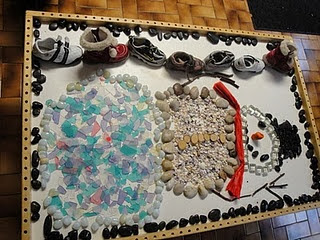The Theory of Loose Parts came from Simon Nicholson. He said that in any environment, the degree of creativity and inventiveness is directly proportional to the number of variables in it. Nicholson suggested that a beach is a good example of a loose parts environment. It has many adaptable materials like sand, water, rocks and sea shells and most children can spend hours absorbed in play there.
Loose parts are materials that can be moved, carried, combined, redesigned, lined up, taken apart and put back together in many different ways. Here are some examples:
- pine cones,
- shells
- stones,
- stumps,
- sand,
- gravel,
- fabric/blankets,
- twigs,
- wood,
- blocks,
- balls,
- buckets,
- baskets,
- crates,
- boxes,
- logs,
- rope,
- beads
- etc.
For more information and ideas... check this out...










No comments:
Post a Comment